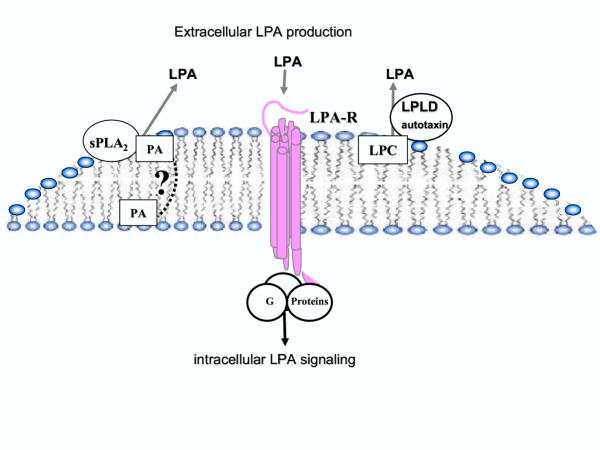The biologically active growth factor LPA has gained broad interest after it was proposed as a possible marker for ovarian cancer [1]. Although much is known about LPA signaling, its physiological and pathological relevance remains unclear. Recent data from Tokumura et al. [2-4] may change our perception of LPA and cause LPA researches to focus on its physiological aspects. LPA functions may also be reflected in the expression of LPA producing enzyme lysophospholipase D (LPLD), which is increased in serum and correlates with the progress of pregnancy [2,3]. Recent exciting data, from the same and other groups, has recognized this enzyme as autotaxin, a cell motility stimulating phosphodiesterase implicated in tumor progression [3,5,6]. At first glance, it may appear contradictory that a factor associated with tumor progression may serve normal physiological functions [7]. To appreciate this better the normal physiology of reproductive systems should be contemplated. Only a few tissues are known to grow under normal physiological conditions and notable among these are the ovary, endometrium, placenta and the growing syncytiotrophoblast. Growth and differentiation of the ovary and endometrium (/placenta) is accompanied by processes which have been likened to inflammation and wound-healing. Unfortunately, these aspects of LPA biology appear to focus the interest of reproductive biologists and gynecologists only, and not the rest of the scientific community. Not only, are reproductive systems part of normal physiological function, but also they provide amenable models for the study of controlled growth and differentiation. May be we should accept that the pathological role of LPA could be a reflection of its physiological functions. In this perspective, Autotaxin may presumably take center stage in future drug discovery associated not only with cancer treatment but also with fertility control.
Figure 1.
Secretory ecto-phospholipases produce biologically active lipid, lysophosphatidic acid (LPA). LPA should be released into extracellular fluid to signal through its specific G-protein coupled receptor (LP-R) [7]. Secretory ecto-enzymes like Lysophospholipase D (LPLD) or secretory-type Phospholipase A2 (sPLA2) act on phospholipd substrates available in extracellular leaflets of the plasma membrane (and can supply LPA directly to its receptors).
References
- Fang X, Schummer M, Mao M, Yu S, Tabassam FH, Swaby R, Hasegawa Y, Tanyi JL, LaPushin R, Eder A, Jaffe R, Erickson J, Mills GB. Lysophosphatidic acid is a bioactive mediator in ovarian cancer. Biochem Biophys Acta. 2002;1582:257–264. doi: 10.1016/S1388-1981(02)00179-8. [DOI] [PubMed] [Google Scholar]
- Tokumura A, Kanaya Y, Miyake M, Yamano S, Irahara M, Fukuzawa K. Increased production of bioactive lysophosphatidic acid by serum lysophospholipase D in human pregnancy. Biol Reprod. 2002;67:1386–1392. doi: 10.1095/biolreprod.102.004051. [DOI] [PubMed] [Google Scholar]
- Tokumura A, Majima E, Kariya Y, Tominaga K, Kogure K, Yasuda K, Fukuzawa K. Identification of human plasma lysophospholipase D, a lysophosphatidic acid-producing enzyme, as autotaxin, a multifunctional phosphodiesterase. J Biol Chem. 2002;277:39436–39442. doi: 10.1074/jbc.M205623200. [DOI] [PubMed] [Google Scholar]
- Tokumura A. Physiological and pathophysiological roles of lysophosphatidic acids produced by secretory lysophospholipase D in body fluids. Biochim Biophys Acta. 2002;1582:18–25. doi: 10.1016/S1388-1981(02)00133-6. [DOI] [PubMed] [Google Scholar]
- Umezu-Goto M, Kishi Y, Taira A, Hama K, Dohmae N, Takio K, Yamori T, Mills GB, Inoue K, Aoki J, Arai H. Autotaxin has lysophospholipase D activity leading to tumor cell growth and motility by lysophosphatidic acid production. J Cell Biol. 2002;158:227–233. doi: 10.1083/jcb.200204026. [DOI] [PMC free article] [PubMed] [Google Scholar]
- Moolenaar WH. Lysophospholipids in the limelight: autotaxin takes center stage. J Cell Biol. 2002;158:197–199. doi: 10.1083/jcb.200206094. [DOI] [PMC free article] [PubMed] [Google Scholar]
- Budnik LT, Mukhopadhyay AK. Lysophosphatidic acid and its role in reproduction. Biol Reprod. 2002;66:859–865. doi: 10.1095/biolreprod66.4.859. [DOI] [PubMed] [Google Scholar]



